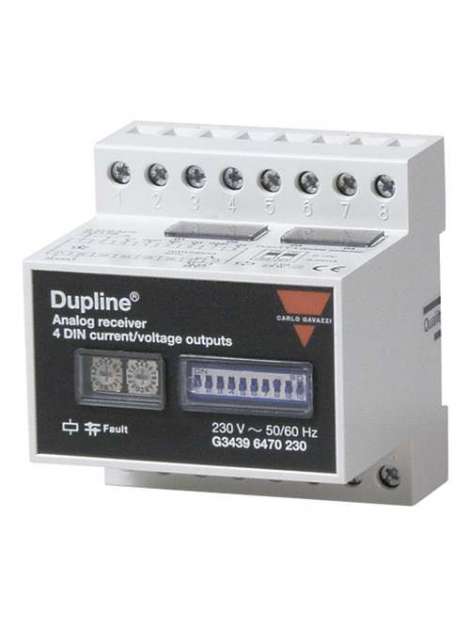



G34396470024, Universal Analog Output Module for DIN Signals Model G 3439 6470, G34396470024, Dupline Universal Module® analog output with 4 outputs and internal power. The module receives digital signals from the Dupline® and converts them into analog outputs. Each output can be selected individually in 0-20 mA, 4-20 mA and 0-10 VDC being possible to have in the same module different types of analog outputs. The transmission format of the Dupline® can be selected to attach the output module in existing installations, or simply to use the most appropriate combination of resolution, signalling capacity and speed. The formats are: 8-bit binary, AnaLink and 3 1/2 digit BCD (with or without multiplexing)., G34396470024, The G34396470 is a universal analog module with 4 outputs. The outputs can be individually configured for signals of 0-20 mA, 4-20 mA and 0-10 VDC, being possible to have different types of output in the same module. The transmission format is selectable and supports all Dupline analog protocols: 8-bit, AnaLink and 3 1/2-digit BCD. The module can be used in normal or multiplexed mode. The encoding of addresses is done by rotary switches and the output and selection of protocols by DIP switches so the GAP 1605 programmer is not required. Regarding the diagram on the previous page, the adjustment of the module must be done as follows: Select a voltage or current signal for each output with the 4 double DIP switches at the top of the module. For an output of 4-20 mA select ON deviation on the corresponding switch on the front panel. The module only emits output signals based on the selected number of outputs enabled on switches 5 and 6. Address assignment for the Analink protocol: If all four outputs are enabled, the module will use four Dup line channels® in consecutive order, starting with the direction adjusted in the two rotary switches on the front panel. Example: The "D7" setting means that output 1 receives on the Dupline channel® D7, output 2 on D8, output 3 on E1, and output 4 on E2. Address mapping for the 8-bit binary protocol: If all four outputs are enabled and multiplexed mode (switch 9) has not been selected, the module will use four groups of Dupline® channels (32 channels) in consecutive order, starting with the group set in the first rotary switch (A-P). The second rotary switch (0-F) is not used in this mode. Example: If "F" is set on the first rotary switch, output 1 receives in the Dupline group® F, output 2 in G, output 3 in H and output 4 in I. If multiplexed mode is selected, the module will use a group of Dupline® channels (8 channels). The first rotary switch (A-P) is used to adjust the group and the second rotary switch (0-F) to adjust the multiplexed direction that will use output 1. Example: If "F" is set on the first rotary switch and "0" on the second, output 1 will receive in the multiplexed direction 0 of the Dupline group® F, output 2 in the multiplexed direction 1 of F, output 3 in the multiplexed direction 2 of F and 4 in the multiplexed direction 3 of F. Address assignment for the 3 1/2 digit BCD protocol: If all four outputs are enabled and multiplexed mode (switch 9) is not selected, the module will use four pairs of Dupline® channel groups (64 channels) in consecutive order. The first rotary switch (A-P) is used to adjust the initial pair of groups. The second rotary switch (0-F) has no function in this mode. Example: If "C" or "D" is set on the first rotary switch, output 1 will receive output 1 in the Dupline channel group® C-D, output 2 in E-F, output 3 in G-H and output 4 in I-J. If multiplexed mode is selected, the module will use a pair of Dupline® channel groups (16 channels). The first rotary switch (A-P) is used to adjust the pair of groups and the second rotary switch (0-F) to adjust the multiplexed direction that will use output 1. Example: If "C" or "D" is set on the first rotary switch and "8" on the second, output 1 receives in multiplexed direction 8 of the Pair of Groups Dupline® C-D, output 2 in multiplexed direction 9 of C-D, output 3 in multiplexed direction A of C-D and output 4 in multiplexed direction B of C-D. Note The selected protocol is valid for all enabled outputs. The module cannot receive different protocols at the same time. Analog receivers should not be used in systems with 2- or 3-sequence channel generators.
No customer reviews for the moment.
Or Insert your account information: